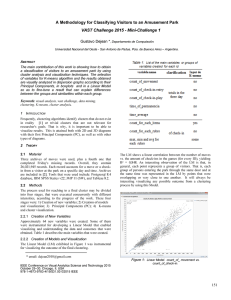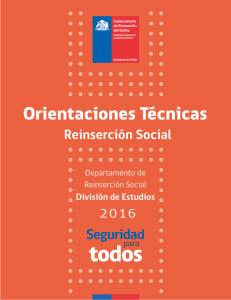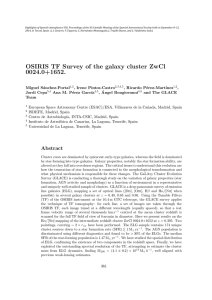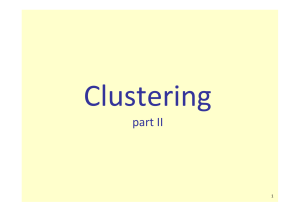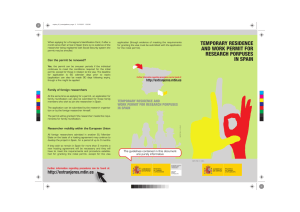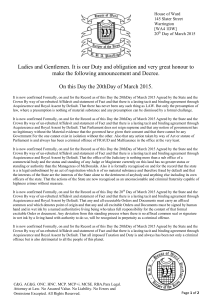CLASSIFICATION OF PRISON INMATES BA
Anuncio
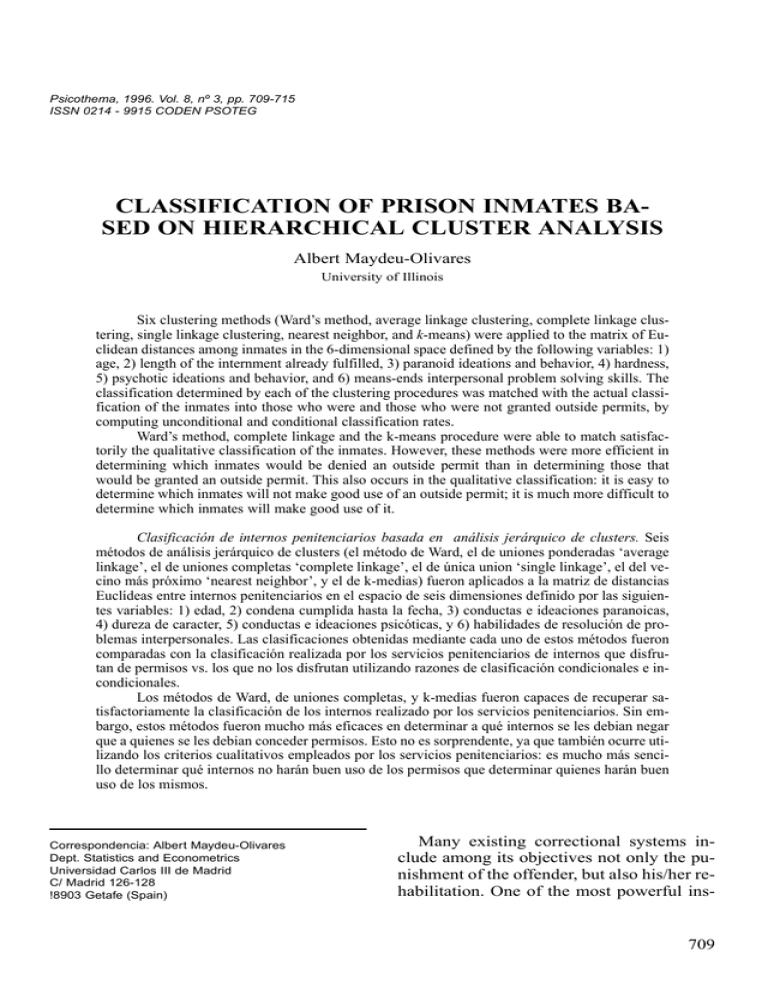
Psicothema, 1996. Vol. 8, nº 3, pp. 709-715
ISSN 0214 - 9915 CODEN PSOTEG
CLASSIFICATION OF PRISON INMATES BASED ON HIERARCHICAL CLUSTER ANALYSIS
Albert Maydeu-Olivares
University of Illinois
Six clustering methods (Ward’s method, average linkage clustering, complete linkage clustering, single linkage clustering, nearest neighbor, and k-means) were applied to the matrix of Euclidean distances among inmates in the 6-dimensional space defined by the following variables: 1)
age, 2) length of the internment already fulfilled, 3) paranoid ideations and behavior, 4) hardness,
5) psychotic ideations and behavior, and 6) means-ends interpersonal problem solving skills. The
classification determined by each of the clustering procedures was matched with the actual classification of the inmates into those who were and those who were not granted outside permits, by
computing unconditional and conditional classification rates.
Ward’s method, complete linkage and the k-means procedure were able to match satisfactorily the qualitative classification of the inmates. However, these methods were more efficient in
determining which inmates would be denied an outside permit than in determining those that
would be granted an outside permit. This also occurs in the qualitative classification: it is easy to
determine which inmates will not make good use of an outside permit; it is much more difficult to
determine which inmates will make good use of it.
Clasificación de internos penitenciarios basada en análisis jerárquico de clusters. Seis
métodos de análisis jerárquico de clusters (el método de Ward, el de uniones ponderadas ‘average
linkage’, el de uniones completas ‘complete linkage’, el de única union ‘single linkage’, el del vecino más próximo ‘nearest neighbor’, y el de k-medias) fueron aplicados a la matriz de distancias
Euclídeas entre internos penitenciarios en el espacio de seis dimensiones definido por las siguientes variables: 1) edad, 2) condena cumplida hasta la fecha, 3) conductas e ideaciones paranoicas,
4) dureza de caracter, 5) conductas e ideaciones psicóticas, y 6) habilidades de resolución de problemas interpersonales. Las clasificaciones obtenidas mediante cada uno de estos métodos fueron
comparadas con la clasificación realizada por los servicios penitenciarios de internos que disfrutan de permisos vs. los que no los disfrutan utilizando razones de clasificación condicionales e incondicionales.
Los métodos de Ward, de uniones completas, y k-medias fueron capaces de recuperar satisfactoriamente la clasificación de los internos realizado por los servicios penitenciarios. Sin embargo, estos métodos fueron mucho más eficaces en determinar a qué internos se les debian negar
que a quienes se les debian conceder permisos. Esto no es sorprendente, ya que también ocurre utilizando los criterios cualitativos empleados por los servicios penitenciarios: es mucho más sencillo determinar qué internos no harán buen uso de los permisos que determinar quienes harán buen
uso de los mismos.
Correspondencia: Albert Maydeu-Olivares
Dept. Statistics and Econometrics
Universidad Carlos III de Madrid
C/ Madrid 126-128
!8903 Getafe (Spain)
Many existing correctional systems include among its objectives not only the punishment of the offender, but also his/her rehabilitation. One of the most powerful ins-
709
CLASSIFICATION OF PRISON INMATES BASED ON HIERARCHICAL CLUSTER ANALYSIS
truments that correctional systems can use
towards this objective is the concession of
permits to leave the prison. These can be
weekend permits so that the inmate can visit his/her family, work permits so that the
inmate can work outside the correctional
institution, etc. Usually inmates who are
granted this type of permits and make good
use of them are eventually granted probation or conditional freedom. The decision
of granting or denying a permit has extremely important individual and social consequences. Type I errors in the decision process (i.e., an inmate granted a permit who
did not return) are generally accompanied
by new criminal acts. Type II errors (i.e., an
inmate denied a permit who would have
made good use of it) have devastating consequences for the inmates. This decision
process is almost invariably made from a
qualitative perspective, and usually must take into consideration a set of legal guidelines that generally focus on variables such as
type of crime, remaining time in prison, behavior during internment, etc. There is also
a long tradition of research that has tried to
show that psychological variables are causally related to performing criminal acts.
Consequently, individual differences on certain psychological variables (e.g., social
skills, psychopathy) have also been used to
support the granting or denial of outside
permits to correctional inmates.
Quantitative rules to assign outside permits to correctional inmates can be readily
developed given a set of psychological and
criminological predictors by means of discriminant analysis, or by more appropriate
methods such as logistic or probit regression. These methods assume that the populations to be classified closely match a multivariate normal, or a multivariate logistic
distribution. Then, by using the information
contained in an actual classification of the
subjects, these methods provide a classification rule. Since these methods use the actual
710
classification of the subjects to derive the
classification rule, the usefulness of such rule must be evaluated by cross-validation.
An alternative approach to classification
can be obtained from cluster analytic methods. Very different approaches to cluster
analysis exist (see Hartigan, 1975; Gordon,
1981; Jain & Dubes, 1988). The approach
that will be used here involves the use of agglomerative hierarchical classification algorithms based on Euclidean distances among
the subjects. Thus, Euclidean distances
among the subjects in the n-dimensional
space defined by a set of n predictor variables are obtained. Hierarchical clustering
methods form nested groups of subjects by
merging subjects or groups of subjects
using a particular algorithm. Five agglomerative hierarchical clustering methods
(Ward’s method, average linkage clustering,
complete linkage clustering, single linkage
clustering, and nearest neighbor) and one
non-hierarchical method (k-means) will be
applied to the matrix of Euclidean distances
among inmates in the 6-dimensional space
defined by the following variables: 1) age,
2) length of the sentence already fulfilled, 3)
paranoid ideations and behavior, 4) hardness, 5) psychotic ideations and behavior,
and 6) means-ends interpersonal problem
solving skills.
For each of the procedures, two clusters
of subjects will be obtained based on their
dissimilarities on these six variables. The
classification determined by each of the
clustering procedures will then be matched
with the actual classification of the inmates
into those who were and those who were not
granted outside permits, by computing unconditional and conditional classification
rates.
True positive and true negative rates are
unconditional classification rates. In this case, the true positive rate is the proportion of
subjects with outside permits correctly classified by the cluster analytic procedure. Si-
Psicothema, 1996
ALBERT MAYDEU-OLIVARES
milarly, the true negative rate is the proportion of subjects without outside permits correctly classified by the cluster analytic procedure. However, for classification purposes, we are mostly interested in conditional
classifications, rather than uncontidional
ones (Widiger, Hurt, Frances, Clarkin, &
Gilmore, 1984). Given a two-by-two classification table, we can obtain, for instance,
Actual classification
Clusters
permit
no permit
1
2
a
c
b
d
- true positive rate = a / (a + c)
- negative positive rate = d / (b + d)
- positive predictive power (PPP) = a / (a + b)
- negative predictive power (NPP) = d /
(c + d)
Of these, PPP and NPP are conditional
classification rates. In our case, the PPP rate is the probability that a subject would be
granted an outside permit given that he/she
has been assigned to cluster 1, whereas the
NPP rate is the probability that a subject
would be denied an outside permit given
that he/she has been assigned to cluster 2.
Method
Subjects
A random sample of 108 male inmates
from a medium security Spanish prison were tested on a large set of variables, including demographic, educational, personality,
psychopathology, intelligence, and social
competence variables. This sample represents approximately a fourth of the total population of the prison at the time of assessment. Details of the characteristics of this
sample can be found in Guillén, MaydeuOlivares, Pons, and Vigil (1989).
Psicothema, 1996
Measures
Six variables were selected from the pool
of available variables by considering all variables that showed a correlation higher in
magnitude than .20 with the actual classification of inmates with outside permits vs. inmates without outside permits, that is,
1) age;
2) length of internment already fulfilled;
3) paranoic ideations and behaviors, as
measured by the Pa-6 scale of a Spanish
adaptation (Roig-Fusté, 1986) of the Minimult version of the MMPI;
4) hardness, as measured by a Spanish
adaptation of the Eysenck Personality
Questionnaire’s Psychoticism scale (EPQP);
5) psychoticism, as measured by the Sc8 scale of a Spanish adaptation (Roig-Fusté, 1986) of the Minimult version of the
MMPI;
6) means-ends social problem solving, as
measured by a Spanish adaptation of the
Means-Ends Problem Solving Questionnaire (Platt & Spivack, 1975).
To remove outliers from the sample, only
those subjects up to 40 years of age and
whose fulfilled length of internment was
less than or equal to 150 months were included. The total available sample was 99
inmates. A further check for multidimensional outliers was performed using the method suggested by Bollen (1989: pp. 128129). No outliers were pointed out by this
procedure.
Procedure
The following clustering algorithms, as
implemented in SAS 6 (SAS Inc., 1990),
were applied to the Euclidean distances
used as dissimilarity measures in the six-dimensional space defined by the predictor
variables:
a) Average linkage clustering (Sokal &
Michener, 1958), where the distance between two clusters is defined as the average dis-
711
CLASSIFICATION OF PRISON INMATES BASED ON HIERARCHICAL CLUSTER ANALYSIS
tance between pairs of observations, one
from each cluster.
b) Complete linkage clustering (Sorensen, 1948), where the distance between two
clusters is defined as the maximum distance
between an observation in one cluster and
an observation in another cluster.
c) Single linkage clustering (Florek, Lukaszewicz, & Zubrzycki, 1951), where the distance between two clusters is defined as the minimum distance between an observation in one
cluster and an observation in another cluster.
d) Ward’s method (Ward, 1963), where
the distance between two clusters is defined
as the squared error criterion.
e) Nearest neighbor method (Wong &
Lane, 1983). This method uses density estimates of a cluster of k-nearest observations
around the cluster center to obtain modified
dissimilarity measures that are subsequently
used to perform single link clustering.
f) K-means (Hartigan, 1975; MacQueen,
1967). This method uses a fixed number of
clusters for which a cluster seed is selected.
Observations are assigned to clusters based
on their distance to the cluster means.
Of these, the first five methods are hierarchical. K was arbitrarily set equal to four
when using the nearest neighbor method.
Since the k-means procedure may yield different solutions depending on the seed used
to start the algorithm, three different random
starting seeds were used with this procedure.
All three produced the same solution. When
using average linkage clustering and Ward’s
method, squared Euclidean distances were
used, as required by these two methods. In
all instances, the distances were computed
from the raw data to incorporate the elevation, scatter, and shape of the subject’s profiles (Cronbach & Goldine, 1953).
Results
In Table 1 the means, standard deviations, and inter-correlations among the six
712
predictor variables are presented for each of
the two groups of inmates: with and without
outside permits. The correlations between
each of the predictors and a dummy variable
representing membership to one group of
inmates or the other is also presented. As
expected, older inmates, inmates that have
been in prison for a long time, and inmates
with better means-ends problem solving
skills are more likely to be granted outside
permits, whereas inmates with symptoms of
paranoia or psychoticism, and those with a
‘hard-core’ personality are less likely to be
granted outside permits. The larger differenTable 1
Means, standard deviations, and inter
correlations among the predictor variables and
the granting/denial of outside permits
a) Correlations between the predictors and the outcome variable (N= 99)
0
age
time
Permit
.17
.37
MMPI-Pa6 MMPI-Sc8
–.20
–.19
EPQ-P
MEPS
–.19
.22
EPQ-P
MEPS
b) Inmates not allowed to leave the prison on permit (N= 88)
age
Age
Time
MMPI-Pa6
MMPI-Sc8
EPQ-P
Mean
Std
27.33
4.51
time
MMPI-Pa6 MMPI-Sc8
.23
–.02
.01
–.38
–.15
.42
–.29
–.09
.45
.44
46.72
23.07
4.30
1.88
4.67
1.83
3.68
2.92
.08
–.15
–.09
.00
–.04
.55
.29
EPQ-P
MEPS
–.03
.55
.29
.40
.11
.74
.18
c) Inmates allowed to leave the prison on permit (N= 11)
age
Age
Time
MMPI-Pa6
MMPI-Sc8
EPQ-P
Mean
Std
29.82
4.21
time
MMPI-Pa6 MMPI-Sc8
.32
.26
.32
–.42
.15
.15
.44
–.20
.22
.14
76.91
31.31
3.10
1.38
3.55
1.63
1.91
2.02
Notes. Permit is coded 0= no permit, 1= permit., time= length of internment fulfilled in months,
EPQ-P= Eysenck’s Personality Questionnaire-Psychoticism, MEPS= Means Ends Problem Solving
questionnarire.
Psicothema, 1996
ALBERT MAYDEU-OLIVARES
ces between both groups of inmates was
found in their fulfilled length of internment.
The base rate of outside permits is 11%.
In Table 2 I present a two-way table with
the results of the clustering classifications
vs. the actual classifications. Numerous ties
were found. In Ward’s method, ties were
found at the following levels: {85, 83, 78,
75, and 73}; in average linkage at {85, 78,
74, and 71}; in complete linkage at {89, 85,
83, 78, 62, 58, and 56}; in single linkage at
{86, 82, 78, 76, 70, 66, 65, 64, 61, 59, 56,
52, 30 and 24}; and in nearest neighbor linkage at {91, 60, 28, and 24}.
Table 2
Two-way classification table for several clustering algorithms
Clusters
obtained
actual classification
outside permit
no outside permit
Total
1
K-means
Ward
Average Linkage
Complete Linkage
Single Linkage
Nearest Neighbor
09
04
00
04
00
00
K-means
Ward
Average Linkage
Complete Linkage
Single Linkage
Nearest Neighbor
37
20
01
27
01
01
46
24
01
31
01
01
2
K-means
Ward
Average Linkage
Complete Linkage
Single Linkage
Nearest Neighbor
02
07
11
07
11
11
K-means
Ward
Average Linkage
Complete Linkage
Single Linkage
Nearest Neighbor
51
68
87
61
87
87
53
75
98
68
98
98
In Table 3 I present the true positive and
true negative rates, and the positive and negative predictive power for all six clustering
methods. As it can be observed, three methods, average linkage, single linkage, and
nearest neighbor gave exactly the same
classifications. The results obtained using
Ward’s method and complete linkage are also very similar. Finally, the k-means procedure yielded a solution close to those offered by Ward’s method and complete linkage.
Psicothema, 1996
Table 3
True positive, true negative, and conditional
classification rates of outside permit
assignment
Clustering algorithm
K-means
Ward’s
Average Linkage
Complete Linkage
Single Linkage
Nearest Neighbor
true
positives
true
negatives
PPP
NPP
.81
.36
0
.36
0
0
.58
.77
.99
.69
.99
.99
.20
.17
0
.13
0
0.
.96
.91
.89
.90
.89
89
Notes. PPP= positive predictive power; NPP= negative predictive power
The solution obtained by using average
linkage, single linkage, and nearest neighbor is very poor. Clearly, these methods failed to form two groups. That is, they assigned 98 out of the 99 subjects in the study to
the no-outside-permit group. They give a
zero true positive rate!, and a 99% true negative rate. They also give a zero PPP rate,
and a 89% NPP rate.
Ward’s method and complete linkage
yielded much better solutions. Of these two
methods, Ward’s method was slightly superior. The best recovery of the actual classification of the inmates was obtained by the kmeans procedure. This procedure gave a
81% true positive rate, but only a 58% true
negative rate. The k-means procedure also
gave the better conditional classification rates. If an inmate is in cluster 2, then there is
a 96% chance that he will be denied an outside permit. However, if he is classified into cluster 1, then there is only a 20% chance that he will granted an outside permit.
Conclusions
Cluster analysis methods based on a
small number of predictors are able to
match satisfactorily a qualitative classification of the inmates. However, cluster analysis are more efficient in determining which
713
CLASSIFICATION OF PRISON INMATES BASED ON HIERARCHICAL CLUSTER ANALYSIS
inmates will be denied an outside permit
than in determining those that will be granted an outside permit. It is important to realize, that this also occurs in the qualitative
classification: it is easy to determine which
inmates will not make good use of an outside permit; it is much more difficult to determine which inmates will make good use of
it. For this reason, it would be desirable to
match the cluster analytic classification not
with the decision of granting or denying an
outside permit, but with the performance of
the inmates during their outside permits,
and eventually, with their long term performance after being released.
It is important to notice that some clustering procedures failed to classify the inmates into two groups. However, when only
two groups are requested the influence of
outliers may cause the clustering algorithms
to fail and although a method of detection of
multidimensional outliers was applied to
this data, no completely satisfactory method
of detecting multidimensional outliers exist.
Therefore, when using cluster analysis, it is
important to use several clustering methods
and compare their results.
Acknowledgements
This research was supported by a FulbrightLa Caixa scholarship to the author, who is now at
Dept. of Statistics and Econometrics, Universidad Carlos III de Madrid, C/ Madrid 126-128,
28903 Getafe (Spain). E-mail: [email protected]
Referencias
Bollen, K.A. (1989). Structural equations with
latent variables. New York: Wiley.
Cronbach, L.J., and Gleser, G. (1953). Assessing
similarity among profiles. Psychological Bulletin, 50, 456-472.
Florek, K., Lukaskzewicz, J., Perkal, J., and
Zubrycki, S. (1951). Sur la liason et la division des points d’un ensemble fini. Colloquium Mathematicae, 2, 282-285.
Gordon, A.D. (1981). Classification. London:
Chapman and Hall.
Guillén, A., Maydeu-Olivares, A., Pons, J., and
Vigil, A. (1989). Resolución de problemas interpersonales y delincuencia: Un estudio
comparativo. [Interpersonal problem solving
and delinquency: A comparative study]. Unpublished document. Departament d’Educació i Psicologia. Universitat de Barcelona.
Hartigan, J.A. (1975). Clustering algorithms.
New York: Wiley.
Jain, A.K., and Dubes, R.C. (1988). Algorithms
for clustering data. Englewood Cliffs, NJ:
Prentice Hall.
MacQueen, J.B. (1967). Some methods for classification and analysis of multivariate obser-
714
vations. Proceedings of the Fifth Berkely
Symposium on Mathematical Statistics and
Probability, 1, 281-297.
Platt, J.J., and Spivack, G. (1975). Manual for
the Means-Ends Problem Solving Procedure
(MEPS). A measure of interpersonal cognitive problem-solving skill. Unpublished document. Philadelphia: Hanhemann Community
Mental Health/Mental Retardation Center.
Roig-Fusté, J.M. (1986). Exploración objetiva
de la personalidad normal y anormal (a través del MMPI) [Objective assessment of normal and abnormal personality]. Barcelona:
Tesys.
SAS Institute (1990). SAS/STAT User’s Guide,
Version 6, Fourth Edition. Cary, NC: SAS
Institute.
Sokal, R.R., and Michener, C.D. (1958). A statistical method for evaluating systematic relationships. University of Kansas Science Bulletin, 38, 1409-1438.
Sorensen, T. (1948). A method of establishing
groups of equal amplitude in analyses of the
vegetation on Danish commons. Biologiske
Skrifter, 5, 1-34.
Psicothema, 1996
ALBERT MAYDEU-OLIVARES
Ward, J.H. (1963). Hierarchical grouping to optimize an objective function. Journal of the
American Statistical Association, 77, 841847.
Widiger, T.A., Hurt, S.W., Frances, A., Clarkin,
J.F., and Gilmore, M. (1984). Diagnostic efficiency and DSM-III. Archives of General
Psychiatry, 41, 1005-1012.
Psicothema, 1996
Wong, M.A., and Lane, T. (1983). A k-th nearest
neighbor clustering procedure. Journal of the
Royal Statistical Society, Series B, 45, 362368.
Aceptado el 23 de marzo de 1996
715
